Overview
↑ Back to topWooCommerce Intuit Payments integrates with Intuit payment services to provide secure and powerful payment processing for your store. With this gateway, you can accept credit cards and eChecks and let customers save their payment details to your site for fast and easy checkouts. This payment gateway includes full support for WooCommerce Subscriptions and WooCommerce Pre-Orders!
Requirements
↑ Back to top- A QuickBooks Online account setup to support Intuit Payments
- PHP 7.4+ (You can see this under WooCommerce > Status)
- An SSL certificate
Installation
↑ Back to top- Ensure your store meets the plugin requirements.
- Download the extension from your WooCommerce dashboard.
- Go to Plugins > Add New > Upload and select the ZIP file you just downloaded.
- Click Install Now and then Activate.
- Click Configure and read the next section to learn how to setup and configure the plugin.
Getting Started
↑ Back to topAs of version 3.3.0 the connection to Intuit Payments has been simplified from previous versions. If you are connecting with a version of Intuit Payments earlier than 3.3.0 or need to migrate from OAuth version 1.0, you can find more information here.
To get connected to Intuit Payments:
- Go to WooCommerce > Settings > Payments > Intuit Credit Card.
- Click Connect to QuickBooks.
- In the popup window, enter your Intuit credentials to connect your account.
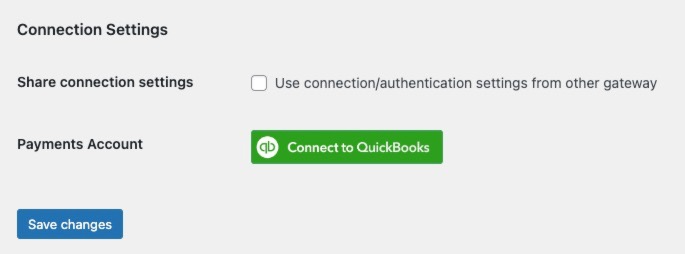
All done! Now you can configure the other plugin settings and process payments.
Credit Card Settings
↑ Back to top- Enable / Disable: Allow customers to use this gateway to checkout.
- Title: The text shown for the payment during checkout and on the Order Received page.
- Description: The text shown under the gateway’s title during checkout. Limited HTML is allowed.
- Card Verification (CSC): Require customers to enter their card security codes when checking out.
- Saved Card Verification: Require customers to enter their card security codes when using a saved payment method at checkout.
- Transaction Type: Controls how transactions are submitted to Intuit Payments. Select “Charge” to automatically capture payments. If you select “Authorization”, you must manually capture and settle payments in your Intuit Payments control panel or on the WooCommerce orders screen after the transaction has been submitted. This defaults to “Charge”.
- Charge Virtual-Only Orders: If Transaction Type is set to “Authorization”, enable this to automatically capture charges for orders with only virtual products. For downloadable products, this will grant downloads access right away.
- Capture Paid Orders: If Transaction Type is set to “Authorization”, enable this to automatically capture charges when orders move to a paid status.
- Accepted Card Logos: Determines which card logos are displayed during checkout. This has no impact on which cards are accepted by your merchant account.
- Tokenization: Let customers save their payment methods for future use at checkout. This is required for Subscriptions or Pre-Orders.
- Detailed Decline Messages: Display detailed messages to customers to provide reasoning for declines instead of a generic error message when possible. Click here to read more about detailed decline messages.
- Debug Mode: Enable when you’re having issues processing transactions. You can choose to log API requests directly on the checkout page, save them to the WooCommerce > Status > Logs page, or both. As a best practice, please do not enable this setting unless you’re having issues with the plugin.
- Environment: Switch between “Test” and “Production” credentials. You can find your test credentials in your Intuit app on the Keys > Development > Keys & OAuth tab.
- Share connection settings: If using the credit card and eCheck gateways, select this setting to share credentials between the gateways so you don’t have to enter them twice. You must Connect to QuickBooks in the eCheck settings if this is enabled here.
- Payments Account: You can connect to QuickBooks here. Once connected, you can Reconnect or Disconnect from QuickBooks here.
eCheck Settings
↑ Back to top- Enable / Disable: Allow customers to use this gateway to checkout.
- Title: The text shown for the payment during checkout and on the Order Received page.
- Description: The text shown under the gateway’s title during checkout. Limited HTML is allowed.
- Tokenization: Let customers save their payment methods for future use at checkout. This is required for Subscriptions or Pre-Orders.
- Debug Mode: Enable when you’re having issues processing transactions. You can choose to log API requests directly on the checkout page, save them to the WooCommerce > Status > Logs page, or both. As a best practice, please do not enable this setting unless you’re having issues with the plugin.
- Environment: Switch between “Test” and “Production” credentials. You can find your test credentials in your Intuit app on the Keys > Development > Keys & OAuth tab.
- Share connection settings: If using the eCheck and credit card gateways, select this setting to share credentials between the gateways so you don’t have to enter them twice. You must connect to QuickBooks in the credit card settings if this is enabled here.
- Payments Account: You can connect to QuickBooks here. Once connected, you can Reconnect or Disconnect from QuickBooks here.
Managing Orders
↑ Back to topAs a site administrator, you can use the WooCommerce Intuit Payments gateway to manually capture charges and automatically refund or void transactions as needed.
Capture Charges
↑ Back to topIf the Transaction Type setting is set to “Authorization”, you can manually capture these payments from the WooCommerce Orders page. Click here to read more about capturing charges.
Automatic Refunds
↑ Back to topYou can process refunds directly in WooCommerce without needing to log into your Intuit account. Click here to read more about issuing automatic refunds from WooCommerce.
Void Transactions
↑ Back to topYou can void transactions directly in WooCommerce in the following circumstances:
- If your Transaction Type setting is set to “Authorization”, you can void when the transaction has been authorized but not yet captured.
- If your Transaction Type setting is set to “Charge”, you can void before the transaction is settled (i.e. funds haven’t been transferred from the customer’s account to your Intuit account).
Intuit Payments does not accept partial voids. If a transaction is no longer eligible to be voided, you must refund the order instead. Click here to read more about voiding transactions in WooCommerce.
Gateway Features
↑ Back to topYour customers can take advantage of the following features when your site uses WooCommerce Intuit Payments.
Saving Payment Methods
↑ Back to topCustomers can save payment methods during the checkout process or from their My Account area. This lets them quickly select payment details during future checkouts and also lets your site support WooCommerce Subscriptions and WooCommerce Pre-Orders.
To manage their saved payment methods, customers can go to My Account > My Payment Methods. From here, they can add new payment methods (credit cards or eChecks), set their default method, and delete any old or expired methods. Click here to read more about managing saved payment methods.
- Please confirm that tokenization is available for your Intuit account with your representative (for both credit cards and eChecks, if you intend to use both). There may be a service charge to enable this.
- Credit card information isn’t stored on your site’s server, but is tokenized and stored on Intuit’s servers. This reduces your site’s PCI compliance burden.
- When using WooCommerce Subscriptions, customers cannot delete payment methods associated with active subscriptions. Click here to read more about saving payment methods with Subscriptions.
Enhanced Checkout Form
↑ Back to topIntuit Payments supports an enhanced checkout form that improves the checkout experience on mobile and desktop devices. Click here to read about the enhanced payment form.
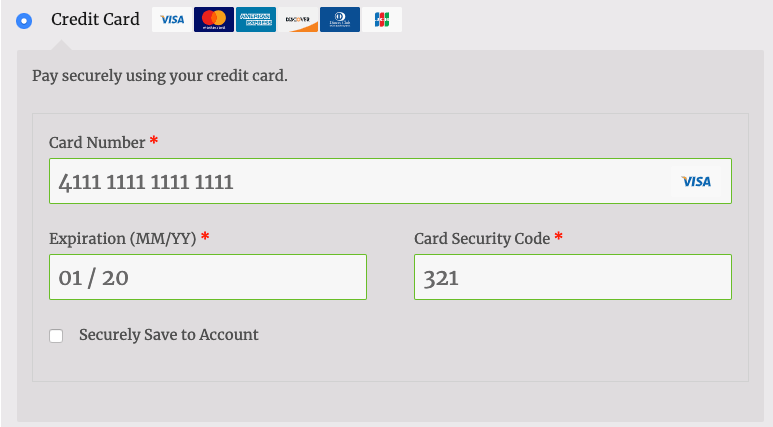
Connecting to Intuit Payments with previous versions
↑ Back to topConnecting with versions prior to 3.3.0
↑ Back to topYou’ll need to create your own app in the developer console to connect your store to Intuit Payments, or you can run the Onboarding Wizard by clicking Setup under the WooCommerce Intuit Payments Gateway plugin in Plugins > Installed Plugins.
Create Your Intuit App
↑ Back to topFollow the steps below to create a free connection app with Intuit:
- Login into the Intuit Developer site.
- Click Dashboard > Create an app.

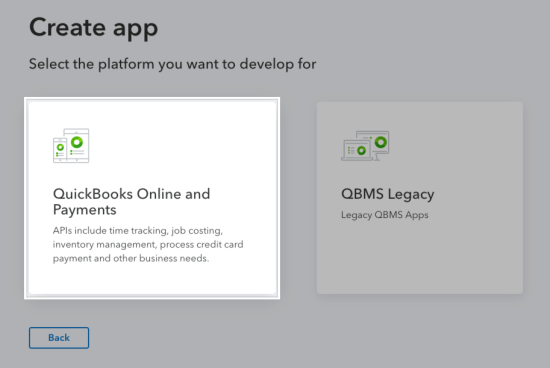
- Enter a name for your app, select “Payments (US only)” for the scope, and click Create app.
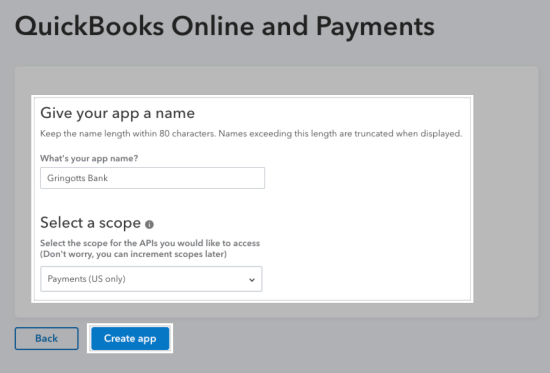
- On the Production tab, update the Terms of Service Links for your site and the Countries you accept connections from setting, if necessary. You’ll also need to select Payments / money movement in the ‘Tell us about regulated industries that use your app’ section. Click Save.
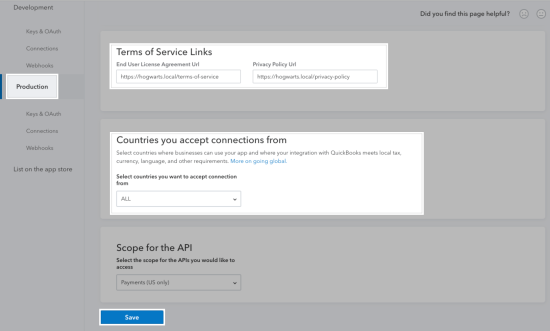
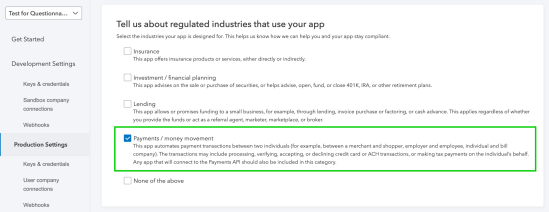
- Go to the App Assessment Questionnaire tab. Fill out the General Questions tab. On the App Information tab, select the last checkbox for question #1. You’ll also need to answer Yes to question #2 and install a reCaptcha plugin on your site. Click the Submit button.
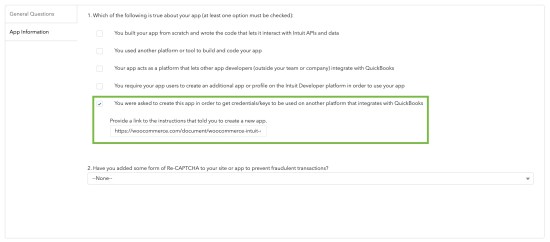
- Once Intuit approves the App Questionnaire, go to the Keys & credentials on the Production Settings tab. Copy the Client ID and Client Secret to enter in the plugin settings.
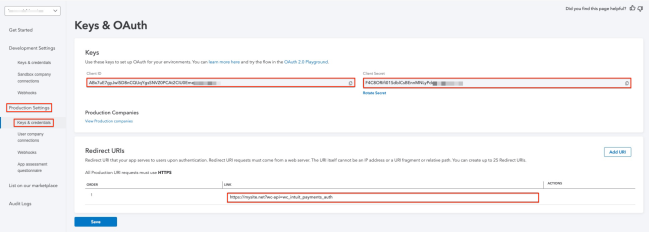
- Update the Redirect URIs field with the URI provided in the plugin settings. This will take the following format (replace “EXAMPLE.com” with your store’s URL):
https://EXAMPLE.com?wc-api=wc_intuit_payments_auth
- Click on the Production Settings link to update the App URLs fields. You can use the homepage or shop domain for your Launch URL and Disconnect URL – these fields are required but don’t require a special URL.

- Click Save.
You’re now ready to proceed with connecting to Intuit from the plugin settings!
Connect to Intuit
↑ Back to topOnce you’ve created your Intuit app, you can connect the plugin to Intuit by following the steps below:
- Enter your Client ID and Client Secret in the plugin settings.
- Click Save changes.
- Click Connect to QuickBooks.
- In the popup window, enter your Intuit credentials to connect your account.
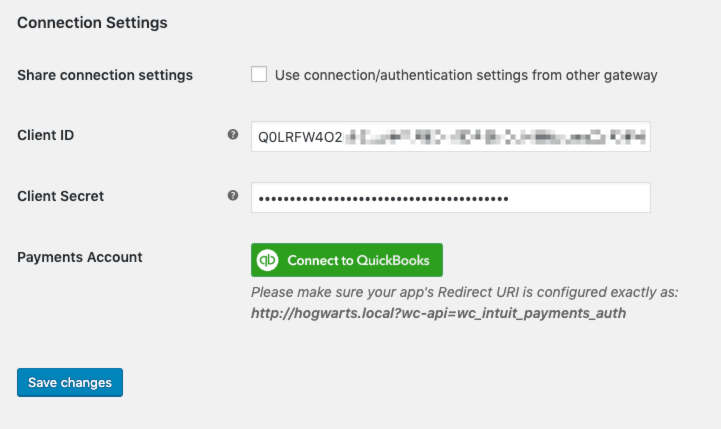
All done! Now you can configure the other plugin settings and process payments.
Migrating to OAuth 2.0
↑ Back to topIntuit is deprecating support for OAuth 1.0, so if you are currently using OAuth 1.0, you should now migrate to OAuth 2.0 to maintain your app’s connection with Intuit by following the steps below:
- Follow Intuit’s instructions for migrating to OAuth 2.0.
- Once migrated, copy your Client ID and Client Secret keys. You’ll need these to update the plugin settings.

- Go to the plugin settings and change the OAuth Version setting to “2.0”.
- Update the Client ID and Client Secret fields with your copied keys.
- Click Save Changes, then Connect with Quickbooks to connect the plugin to Intuit using the OAuth 2.0 keys.

How do I know what OAuth version I’m currently using and whether I need to migrate?
There are a few ways to tell!
- Do you see an admin notice in WordPress telling you to migrate? If so, you’re currently using the OAuth version 1.0.

- Check the credentials listed in your plugin settings. If your OAuth Version field is set to “1.0”, you’ll need to migrate.
Frequently Asked Questions
↑ Back to topQ: My store is being targeted with fraudulent orders. How can I prevent this?
A: Bad actors often target WooCommerce stores to test stolen credit card numbers, which can result in many fraudulent orders on your store. To discourage this, we recommend using a reCaptcha tool, such as reCaptcha for WooCommerce, to protect your store.
Q: Does this gateway support legacy QuickBooks Merchant Services (QBMS) accounts?
A: Existing installations of this plugin can be used with legacy QBMS accounts. However, we cannot support merchants using this account, so merchants must be using Intuit Payments to receive active support. New installations will use Intuit Payments by default.
Q: Why do I get errors while using the test/production environment?
A: Please check your plugin settings to ensure you’re using production keys in the “Production” environment and test keys in the “Test” environment. You can find both sets of keys in your Intuit developer app.
Q: Will this plugin send purchase details to my Quick Books Online account?
A: This plugin only serves as a payment gateway integration with Intuit’s payment processing services, so it cannot send transaction details to your Quick Books Online account.
Q: Do I have to refresh my connection to my Intuit app manually?
A: Nope! The plugin will do this for you automatically on a recurring basis.
Q: Is this plugin compatible with Intuit Pay?
A: According to Intuit Pay Support, they do not currently support eCommerce integrations. This is planned for a future Intuit Pay system update, but there’s no firm ETA yet.
Q: Does this work with QuickBooks Payments?
A: Yes and no. Unfortunately, Intuit names many of their products the same way. This plugin works with the eCommerce processing side of Intuit QuickBooks payments, which can be used with or without Quickbooks. Sometimes this is confused for another version of QuickBooks payments, which is done via QuickBooks online. This service will not work with our gateway integration to the best of our knowledge.
Q: Is this plugin compatible with AVS (Address Verification Service)?
A: The short answer is no. Our plugin depends on the payment status sent by the payment processor to approve or reject transactions. The address verification, however, is handled as a different parameter (or part) of the response which can cause orders to be approved even if the AVS fails. Our team is in the process of reviewing possible changes, so don’t hesitate to reach out to us if you’d like more information.
Troubleshooting
↑ Back to topDifficulty Connecting to Intuit
↑ Back to topDid you encounter the following error when trying to connect to Intuit?
“We’re sorry! We’re experiencing some problems. Please try again later.”
There are a few potential causes:
- Ensure your Redirect URI is properly configured in your Intuit app. You can find the correct Redirect URI for your store in the plugin settings.
- Ensure your OAuth version is properly configured in your plugin settings. Not sure which OAuth version you’re using? Click here for tips on determining which version you’re using.
If your error looks like this (note the additional “We’re updating our platform…” text), this is due to changes made by Intuit to a small number of new merchants. Unfortunately, according to Intuit, there’s nothing our plugin can do to correct this issue. If you encounter this error, please contact your Intuit representative so they can assist and ensure you can accept payments with the plugin.
If you are receiving this message “Uh oh, there’s a connection problem. Sorry, but the app didn’t connect. Please try again later, or contact customer support for help” when connecting your app to Intuit or are having issues processing transactions, double-check that the Intuit Developer account that you have used to create your app is the same account you use to log into your QuickBooks Online account with.
“This app no longer meets our guidelines and standards.” Error
↑ Back to topIntuit has added additional questions to their App Questionnaire. When the above error occurs, it’s usually due to incomplete App Questionnaire sections that need to be filled out. Please check your Intuit Account and see if there are any App Questionnaire questions that need to be answered.
Provided card type is invalid. Provided token is invalid.
↑ Back to topIf you receive an error like Provided card type is invalid. Provided token is invalid., there is likely a JavaScript conflict or error of some kind on your Checkout page, typically with your theme or another plugin. Often times, optimization plugins interfere with how JavaScript loads on your checkout page and cause this error. A few conflicting plugins to look for are:
- Autoptimize
- SG Optimizer
- Hummingbird Pro
If you are using one of these plugins, disabling the plugin completely or adjusting its settings so they don’t optimize your checkout page should help resolve the error.
If the error persists, try briefly changing to a default theme, such as Twenty Nineteen to rule out any theme conflicts.
Other Issues
↑ Back to topHaving a different problem? Follow these steps to make sure everything is setup correctly before posting a support request:
- Please ensure that your site meets the plugin requirements.
- Check the FAQs to see if they address your question.
- Enable Debug Mode in the plugin settings and review the error codes/messages provided by Intuit Payments. If the error points to an issue with the plugin, please submit a support ticket and include the logs to help us troubleshoot.
Questions & Support
↑ Back to topHave a question before you buy? Please fill out this pre-sales form.
Already purchased and need some assistance? Please check out our troubleshooting tips and frequently asked questions for common issues or contact support via the help desk if you need more help.

